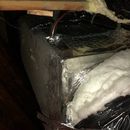Insulating my attic that has a sloping roof
I live in Montreal whose weather is similar to that of VT and upstate NY. I installed a heat pump in my house that has the blower coil in the attic through insulated ducts. I use the heat pump as an air conditioner in the summer and heat in the winter until the temperature reaches -12°C (10°F) after which my oil furnace takes over.
The compressor generates heat that unfortunately warms my attic in the winter and melts the snow on my roof. Since the back of my house only gets the morning sun, an ice dam forms in the gutter and water backs up past the water membrane causing water to drip into my house.
I am reluctant to replace the heat pump with a ductless one since my house in on 4 levels. My question is this: Is it possible to insulate the blower coil to prevent heat from escaping?
Currently I have cellulose in the attic but I do no know what the R value is? My plan is to remove all the cellulose in the attic since some of it is now wet, insulate all the holes and the ducts and then add new cellulose to get R50, recommended by Hydro Quebec. But I would still have the compressor problem to deal with.
I know that I can extend to house envelope by putting spray foam on the sheathing but the foam is carcinogenic and also inflammable. I see from your blog that I would also have to cover the foam with a fire resistant material. This all seems complicated and would increase my cost substantially.
I have attached 2 pics of the current state of the blower coil.
What do you suggest I do?
GBA Detail Library
A collection of one thousand construction details organized by climate and house part











Replies
The indoor unit with the air blower & heating/cooling coil is an "air handler", not a "compressor". The refrigeration compressor is always located in the outdoor unit of a heat pump.
If the ducts & air handler are well sealed you can bury them in blown insulation or wrap/cover them with tight fitting batt insulation, which will reduce the ice-damming potential. Most ducts don't have more than a couple inches of insulation, and when running the air is warmer than the indoors. Insulation the ducts and air handler with 5-10" of additional insulation will make a difference.
If the ducts leak much air into the attic, burying them in insulation risks condensing the humidity out of the leaking air and accumulating in the insulation. The amount of moisture accumulation can be substantial over an entire winter and may not be noticeable at first (especially if it form frost or ice), eventually dripping through the ceiling when it it's saturated (or thaws). But after careful air sealing it can work just fine.
Lorne,
Installing HVAC equipment and ductwork in a vented, unconditioned attic is always a mistake, and GBA has many articles warning homeowners and builders not to install equipment in this type of attic.
You have two basic choices:
1. Abandon this equipment and use some other type of heating and cooling equipment, or
2. Convert your vented unconditioned attic into an unvented conditioned attic.
Here is a link to an article with more information: "Creating a Conditioned Attic."
Thanks for your suggestions. Can't take the equipment out since I have too much invested in it but wrapping the blower coil tightly with insulation was what I had planned to do and it is encouraging to know it is possible to do without damaging it.
Keep in mind to seal first Lorne! Every seam needs mastic or a certified tape (foil) as insulation won't stop the problem if it leaks air.
I agree with Martin's assessment of the two ways that make the most sense to solve the problem. However, I could have sworn that the Building America Solution Center had a document on how to build a mini-HVAC "room" around the air handler as well as encapsulating ducts in an unconditioned attic.
I just search the Solution Center (https://basc.pnnl.gov/search/air%20handler%20unconditioned%20attic) and could not find the reference but check out the resource nonetheless.
Peter
Peter,
I'm not sure whether the Building American Solution Center has such a document, but I have written an article on the topic. Here is the link: "Should I Build a Mechanical Room in My Attic?"